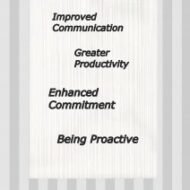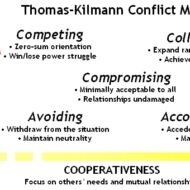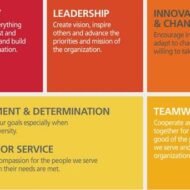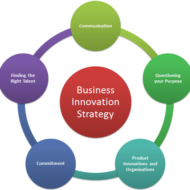Posted by Managementguru in Strategy
on Mar 2nd, 2015 | 0 comments

Advantages of Strategic Management A couple of definitions on STRATEGIC MANAGEMENT Strategic management involves formulation and implementation of the major goals and plans taken by a company’s top management on behalf of owners, based on consideration of resources and an assessment of the internal and external environments in which the organization competes. The methodical analysis of the factors associated with customers and competitors (the external environment) and the organization itself (the internal environment) to provide the basis for maintaining optimum management practices is another well known definition. The objective of strategic management is to achieve better alignment of corporate policies and strategic priorities. Advantages: 1. Discharges Responsibility The process of strategy formulation satisfies the expectation from shareholders, stakeholders and the general public at large, that a strategically managed organization will discharge its duties successfully. 2. Allows an Objective Assessment Strategic management provides a CONTROL that allows the senior management team to take a step back from the day-to-day business and CONTEMPLATE about the future of the organization. 3. Faciliatates to Make Wise Business Decisions Strategy provides the framework within which EXECUTIVES at lower and middle levels can make day-to-day operational decisions that are aligned with the accomplishment of the organization’s goals. 4. Enables Understanding and Improves co-ordination between different departments Allowing participation in the strategic management process enables better understanding of the direction, why that direction was chosen, and the associated benefits. Good strategy formulation and communication process are vital steps in enabling effective and efficient strategy deployment. 5. Simplifies Measurement of Progress Strategy sets the direction and empowers an organization to bring into line its objectives and performance measures. These objectives and performance measures allow meaningful information to be provided to decision-makers regarding the organization’s progress through such tools as scorecards and dashboards. 6. Enhances Strategic Agility (Innovation) When a firm can successfully capitalize upon opportunities resulting from unanticipated and significant change, it is said to be innovative as it has a competitive edge over other firms. 7. Ensures Allocation of Resources: The limited resource is properly allocated to different functional levels so as to create value for all stakeholders. A targeted approach to markets and opportunities obviously strengthens your bottom line. A simple representation will make your understanding better: Enhanced Communication DIALOGUE PARTICIPATION | | Deeper/Improved Understanding OF OTHER’S VIEW OF WHAT THE FIRM IS DOING | | Greater Commitment TO ACHIEVE OBJECTIVES TO IMPLEMENT STRATEGIES TO WORK HARD | | The Result ALL MANAGERS AND EMPLOYEES ON A SINGLE MISSION TO HELP FIRM SUCCEED...

Posted by Managementguru in Human Resource, Organisational behaviour, Principles of Management, Strategy, Training & Development
on Mar 31st, 2014 | 0 comments

Conflict is a Part of Organizational Life Managers need to be alert to the presence of conflicts. Their focus should be oriented towards the goals to be accomplished. If there is a conflict, they should aim to resolve it smoothly by not over-reacting to the situation. They should take the help of persons who can best settle the issue, be ready to bargain and not issue orders. Their concentration should be on the problem and not on persons. True to the saying – Am I not destroying my enemies when I make friends of them?- President Abraham Lincoln Conflicts are Functional and Healthy: Conflicts in organisations are generally considered to be dysfunctional. On the contrary, many top executives of big companies view conflicts, as a means, to sufficiently analyse a problem and postpone decision making until all critical aspects of an issue are evaluated properly. Conflicts may occur within the individual, between individuals, between the individual and the group or between groups. There are many potential sources of conflict in today’s corporate organisations. The complex inter personal relationships and high degree of interdependence causes friction. Difference of Opinion: When many people must work together, conflict is inevitable, as it is human nature to clash and complain. Conflict is the personal divergence of interests between groups or individuals. The need to share scarce resources, difference in goals between organisational units, difference in values, attitudes and perception, ambiguously defined work responsibilities are some of the major sources of conflict. Functional Conflicts: Functional conflicts support the goals of a group, improve its performance and are constructive in nature. Dysfunctional conflicts hinder the performance of a group and are destructive in nature. It has not been precisely defined, as to what criterion demarcates functional from the dysfunctional. It is only the group’s performance and the delivered result or outcome that determines the nature of the conflict. Conflicts, irrespective of their type can bring these benefits to the firm: Bring hidden issues to the surface. Encourage creativity and innovation. Improves communication and make changes more acceptable. Increases group cohesion. Strategies to Resolve Conflicts: So, what kind of strategy do you think best suits in resolving conflicts? Avoiding or smoothing conflicts may be a temporary measure, only to bounce back in full force. Forcing might create undesirable consequences. The only option left is to confront the situation, face-to-face meeting of the conflicting parties for the purpose of identifying the problem and resolving it through an open discussion. Make Structural Changes to Lessen Conflicts: By making structural changes, conflicts can be managed. The objectives of a group are modified and then integrated to suit the purpose. Also changes in the structure of the organization, that is, clarification of authority-responsibility relationship, improving the working atmosphere, ambience and work locations help in resolving conflicts. Proper Communication: Lack of proper communication, ego clashes between the people in line and staff positions, a superior’s autocratic leadership style, differing educational backgrounds, lack of co-ordination between inter-departments are all rich sources of conflict. These can be resolved with the right kind of attitudinal approach and an open mind from the management’s...

Posted by Managementguru in Business Management, Entrepreneurship, Human Resource, Organisational behaviour, Principles of Management, Training & Development
on Mar 30th, 2014 | 0 comments

Values and Beliefs in Organizations What are Values and Beliefs in an Organization: An organisational value is “a belief that a specific mode of conduct is preferable to an opposite or contrary mode of conduct.” Infosys Narayanamoorthy on Value System : Our team was unique in our commitment to a strong value system. We believed in putting the interest of the company ahead of our own interest. We believed in legal and ethical business. A sound value system is what differentiates long-term players from others. Core Values of an Organization: Increasingly, organizations are setting out the core values that they think should govern the behavior of all their employees. Value statements may be produced which define core values in areas such as: Care for customers Concern for people Competitiveness Enterprising Excellence Flexibility Growth as a major objective Innovation Market/customer orientation Productivity Quality Teamwork But, is that all? By just defining what you think is important to guide the action of your employees may not suffice the cause. How do you put them into action! That’s where the secret lies. Imitating the Boss: How do you make people do what you want them to do! Just by being a precedence or role model for your followers, is that not true? The best example that can be cited is the school atmosphere, where the kids take to their teachers. They simply, blindly follow or imitate whatever their masters do. I think IMITATION is the right word, because it makes people easily inclined to the behavior that is appreciated by the organisation’s atmosphere. When you imitate your boss you get a surreal feeling of being a boss at least for that time being. Coercion is not the Right Approach: It is a general fact that it is very difficult to train or mould people the way we want to. And again it can be argued that people can be trained or molded very easily when you have the right kind of motivation and guidance. The core values should be INBUILT; it should be there RIGHT FROM THE START. If you have able managers to run your teams it becomes a cake walk for you to train the individuals without much COERCION. The authority and influence which the team leader has over the team says it all. Influencing the Employees the Right Way: Everybody in an organization plays their own role in cherishing the values imbibed and focus on achieving results, and keenness to “GET GOING AND KEEP GOING”. High work output is expected from a clerical staff, the Supervisor can be depended on for effective organization and control of teams and their work. THE MANAGER is clear about what “success “means for the business and is resourceful in overcoming obstacles. THE SENIOR MANAGER maintains focus on the “BOTTOM LINE” despite continuous changes to procedures and systems, and the EXECUTIVE is focused on results even when dealing with very diverse complex tasks and proactive in tackling mistakes. Performance of Value Oriented Organizations: Value Oriented Organisations perform definitely better than others and achieve their targets in a quick manner. Values give direction to the firm backed up by solid principles to guide the action of the employees and also the commitment and determination to achieve whatever is due. Reliance Industries Limited stands as a testimony for a single man’s dream and vision and his core value was CUSTOMER SATISFACTION. To scale to greater heights, you also need STRONG WILLED PEOPLE RIGHT ATTITUDE ACTION PLANS STRATEGIES PERSISTENCE DETERMINATION and PASSION Values add integrity and honor to your organization and you should always remember that to hold your values you...

Posted by Managementguru in Business Management, Change management, Principles of Management, Strategy
on Mar 26th, 2014 | 0 comments

Innovation – The BUZZ Word Execution with Perfection: Technological advancement in the fields of aerospace, computers and communication has transformed the world we live in today, into a ‘GLOBAL VILLAGE.’ While most of the countries look to the U.S to adopt and follow management techniques , it is quite amazing to know that the U.S look to Japan for implementing these techniques more effectively. As we all know that Japanese are very good when it comes to “Execution with Perfection.”The point here is not to establish or brand that one is better than the other but rather to suggest that many countries can contribute to innovative managerial theories and practices and let it be a mutual affair. Management practices and thinking: Innovation is the Buzz word that has defined the paradigm shift in the approach of management practices and thinking. This has helped organizations grow and sustain regardless of competitor and market pressure and challenges. Innovation management gives entrepreneurs the liberty to think out of the box and come up with new ideas leading to the development of new products, processes and services. Change is Inevitable: Change is inevitable and change is the one that never changes. People love variety and it is the responsibility of business people to satisfy the customer wants and requirements. New approaches are required to avoid monotony and stereotyping. “Old wine in a new bottle” concept may come in handy when you feel that your product has reached the saturation point and about to decline in its life cycle. Picture Courtesy: Digital Information World Inspiration from the Internet Let us look at some services available on the Internet that exist as proofs for innovative and strategic thinking: 1. IRCTC – The e-ticketing portal of Indian Railways. Saves lot of time and effort. Connects huge number of metros and small towns. Tatkal scheme is a huge hit and a great revenue generator for the railways. The interface is very user friendly and interactive. 2. Bharat Matrimony – Online matrimonial service that assists brides and grooms to find their perfect partners. Profiles can be created to express your views and expectations on your life partner. 3. Make my Trip – Helps you to plan your travel, ticketing and accommodation, all in one place. Extensive data is available for people’s benefit. 4. Facebook – Gives you the liberty of having your own space to connect with number of people. Helps as well to promote your business. Facebook generates huge revenue through advertisement banners positioned at the right niches. 5. Twitter – Again a social networking portal that helps in link building. Retweets make the scope of you reach wide and bright. Education Portals: Educational portals that offer online learning, management portals that teach online MBA, Auction websites with numerous products at affordable prices, travel websites, online portals for paying tax and duties have transformed the lives of individuals and organizations for good. The full bloom of internet is yet to be seen when many more third world nations will have the opportunity to access the...

Posted by Managementguru in Business Management, Change management, Principles of Management, Project Management, Technology
on Mar 25th, 2014 | 0 comments

Technology and Society Perhaps the most striking influence of technology is found on society. Practically every area of social life and the life of every individual has been, in some sense or the other, changed by the development in technology. Technology reaches people through business: Preferences of people are constantly changing and this has pushed the business firms to the point, where innovation has become the need of the hour. The new discoveries would remain idle as mere ideas if there were no laboratories to transform the ideas into creations. Technology reaching people through business is one part of the theory. The economic prosperity of a nation depends on technology. The Non-Technical Person’s guide to building products & apps High expectations of consumers: People are used to technological innovations and breakthroughs and they want variety in every kind of purchase they make. New varieties of products, more safe and comfortable, free from pollution, are to be produced and supplied to affluent sections. This calls for a massive investment in research and development. In countries like Japan, much importance is attached to product design, quality, sophistication, delivery schedules and prices. High expectations need not be considered as problems by business persons but treated as an opportunity to satisfy their customer group. System complexity: Technology has resulted in complexity. Modern machines work faster and better, no doubt. However, if there is a technical problem, the presence of an expert is needed to repair the machinery. Again, investment in machinery adds to the cost of capital and hence the merchandise has to be purchased form reliable sources. Social change: The change in the technological process undoubtedly has its effect on the society. First, there is a change in the social life, with mobile populations drifting about in search of new centers of employment. If it happens to be an agricultural economy, the result of such a drift would prove disastrous, with society being socially uprooted. Sometimes such a drift may result in new geographical distribution of population. Technological change also brings considerable changes in the family, life style and attitude. The way we cook, communicate, use media and work are all affected by technology. Technological phases and the social systems they create: There are five stages of technological development. Each stage leaves a distinct influence on work and on social system. Sequential progress is made from the lowest level to the highest level, in such a way that these five stages roughly represent the progress of civilization throughout history. Although one phase of technology tends to dominate a nation’s activities at a particular time, other phases will be often practiced at the same time. Technology means change and more change. It forces changes on people whether they are prepared for it or not. In modern history, it has created what is called future shock, which means that change comes so fast and furious that it approaches the limits of human tolerance and people lose their ability to cope with it...










